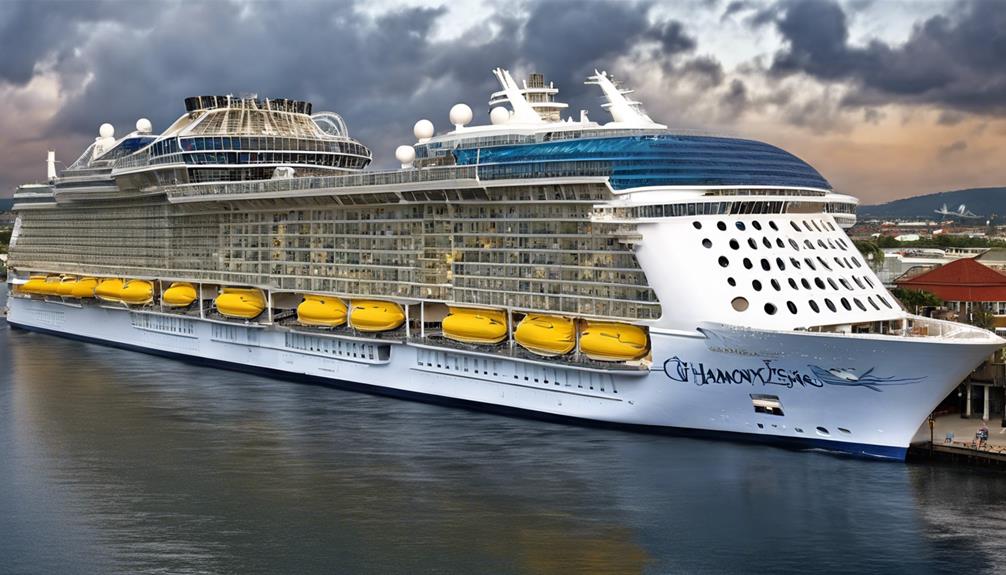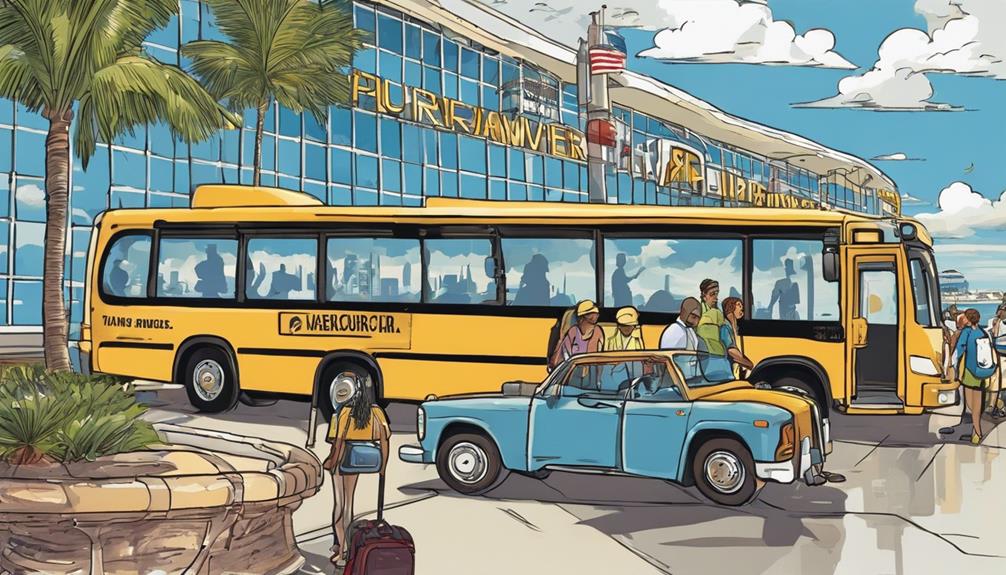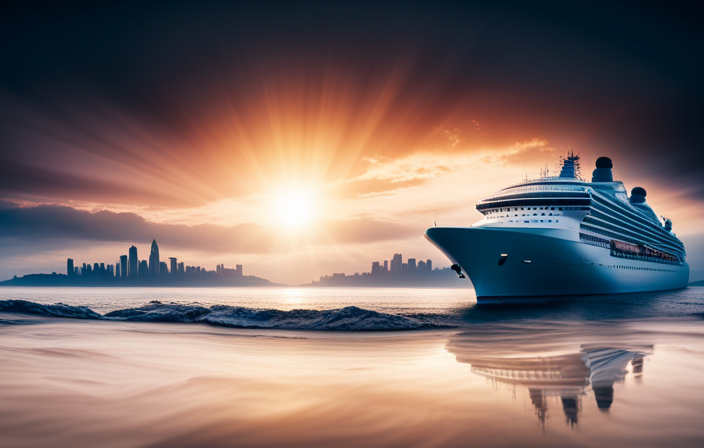Delving into the recent incident where the Harmony of the Seas collided with a dock in Jamaica, it’s evident that the importance of this event should not be understated. There is an increasing interest in understanding the series of events that led up to the collision and the aftermath that ensued.
What factors contributed to this unexpected turn of events, and how did the crew manage the situation? Stay tuned as we uncover the details surrounding this maritime incident and its implications.
Key Takeaways
- Pilot misdirection caused collision with dock pylon in Falmouth, Jamaica.
- Swift response by maintenance crew repaired minor cosmetic damage.
- Stringent safety measures implemented post-incident for passenger and crew safety.
- Ongoing investigation focuses on legal implications and possible procedural changes.
Collision Incident Overview
During the berthing process at 7 a.m. in Falmouth, Jamaica, the Harmony of the Seas experienced a collision incident as its aft collided with a mooring pylon, resulting in the collapse of the pylon and causing minor cosmetic damage to the ship.
The impact necessitated swift action from the maintenance crew, who promptly repaired the cosmetic damage to ensure the ship could continue its sailing itinerary without disruption.
The Minister of Tourism attributed the incident to pilot misdirection, emphasizing the critical need for precise maneuvering during docking procedures.
Despite the collision, the Harmony of the Seas maintained its scheduled itinerary, with repairs being carried out at the port while divers worked to recover the broken elements.
This incident underscores the importance of careful navigation and highlights the swift response capabilities of the ship's maintenance team in addressing unexpected challenges.
Harmony of the Seas Details

Indubitably, the Harmony of the Seas stands as an impressive vessel in the Royal Caribbean fleet, renowned for its opulent amenities and capacity to cater to thousands of passengers and crew. The collision with the dock in Falmouth, Jamaica, resulted in cosmetic damage like dents and paint scrapes on May 26. Despite this incident, no injuries to crew members or guests were reported. The Harmony of the Seas is celebrated for its luxurious amenities, entertainment options, and ability to accommodate a large number of passengers and crew.
| Features | Description |
|---|---|
| Cruise Line | Royal Caribbean Internationals |
| Ship Name | Harmony of the Seas |
| Incident Location | Falmouth, Jamaica |
Royal Caribbean confirmed the collision and reassured that there would be no disruptions to the cruise schedule, emphasizing the safety of crew and guests. This incident, while causing cosmetic damage, did not compromise the overall functionality and safety of the vessel.
Dock Collision Location
Falmouth, Jamaica served as the setting for the recent collision involving Harmony of the Seas. This incident has raised questions about the cause of the collision, its impact on the ship, and the safety measures implemented during the docking process.
Understanding the specifics of the location and its potential role in the collision is crucial for assessing the overall handling of the situation.
Dock Collision Cause
Pilot misdirection led to the collision at the aft of the ship in Jamaica, causing it to collide with a mooring pylon resulting in its collapse.
- The incident highlighted the critical role of precise navigation during docking procedures.
- Colliding with the mooring pylon raised concerns about the infrastructure's durability and resilience.
- The swift response of the maintenance crew showcased the importance of preparedness for post-collision repairs.
The collision, occurring during the berthing process, resulted in minor cosmetic damage to the ship but more substantial damage to the dock structure. This event underscores the necessity for heightened vigilance and coordination to prevent mishaps during docking maneuvers, ensuring the safety of both the vessel and the port facilities.
Impact on Ship
The collision on Harmony of the Seas at the aft of the ship, where it struck a mooring pylon leading to its collapse, resulted in minor cosmetic damage to the stern and prompt repairs by the maintenance crew. The impact of the collision was contained to the dock area in Jamaica, with the mooring pylon bearing the brunt of the force. Despite the collision, the Harmony of the Seas managed to maintain its scheduled itinerary without any disruptions. The swift action taken by the maintenance crew ensured that the cosmetic damage on the ship was quickly addressed, allowing the vessel to continue its journey smoothly. Below is a table highlighting the key points of the impact on the ship:
| Aspect | Details |
|---|---|
| Damage Location | Aft of the ship at the stern |
| Type of Damage | Minor cosmetic damage |
| Repair Timeline | Prompt repairs by maintenance crew |
Safety Measures Taken
Implementing stringent safety measures following the dock collision in Falmouth, Jamaica, ensured the well-being of both passengers and crew aboard the Harmony of the Seas. The prompt assessment of the minor cosmetic damage to the ship's exterior helped maintain operational efficiency.
Royal Caribbean's confirmation of the collision incident and the immediate repair of the damage demonstrated a commitment to passenger and crew safety. Safety protocols were diligently followed to prevent any disruptions to the voyage schedule, ensuring a seamless experience for all onboard.
The quick response to the collision underscored the cruise line's prioritization of safety and security for everyone involved in the unforeseen event.
Passengers' Eyewitness Accounts
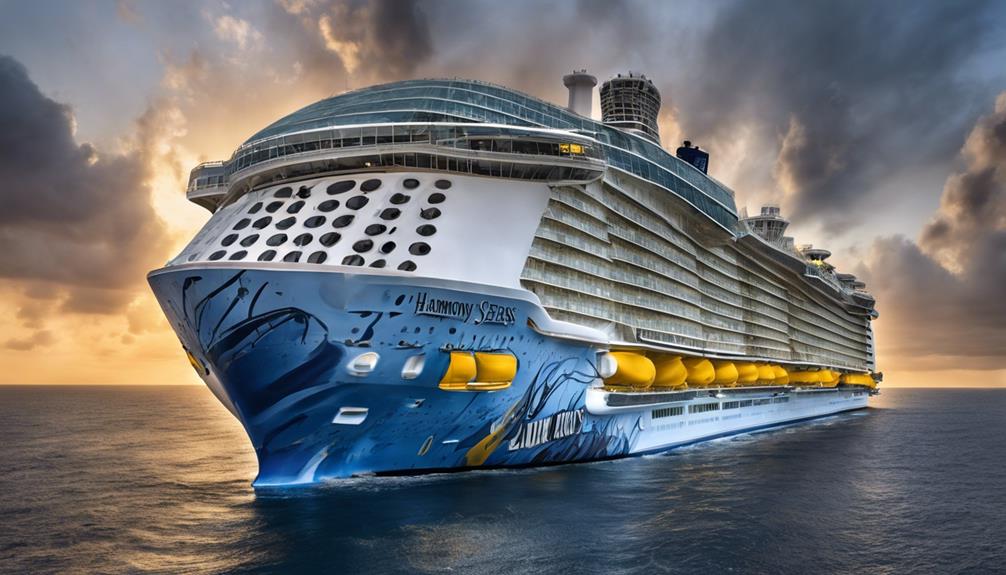
Eyewitness accounts following the collision of Harmony of the Seas with the dock in Jamaica depict a sudden jolt and audible impact felt by passengers. Passengers reported feeling a significant vibration as the ship made contact with the dock, accompanied by a loud noise that resonated throughout the affected areas. Some passengers witnessed the collision causing visible damage to the ship's stern, prompting immediate concern among those onboard. Despite the initial shock, eyewitnesses observed crew members swiftly springing into action, assessing the damage and initiating necessary repairs. The efficient handling of the situation by the crew members played a crucial role in reassuring guests about the safety of the ship following the incident. This quick response helped to maintain a sense of order and calm among the passengers, highlighting the crew's professionalism and dedication to ensuring the well-being of everyone onboard.
| Eyewitness Accounts | Description | Impact |
|---|---|---|
| Sudden jolt | Significant vibration | Felt |
| Audible impact | Loud noise | Heard |
| Visible damage | Stern of the ship | Seen |
Authorities' Investigation Progress

Authorities investigating the collision between Harmony of the Seas and the dock in Jamaica are currently analyzing docking procedures, communication protocols, and potential technical issues that may have contributed to the incident. The investigation by port authorities aims to ensure the safety and efficiency of maritime operations in the area. Here are three key aspects being looked into:
- Human Error Assessment: Experts are examining if any mistakes were made in the handling of the ship during the docking process, including decisions made by the crew or communication errors that might've occurred.
- Equipment Inspection: Investigators are scrutinizing the ship's technical systems to identify any malfunctions or failures that could have played a role in the collision, such as issues with the propulsion system or navigational equipment.
- Procedural Review: Authorities are reviewing the standard operating procedures in place for docking at the port to determine if there are any gaps or areas that need improvement to prevent similar incidents in the future.
Causes of the Collision
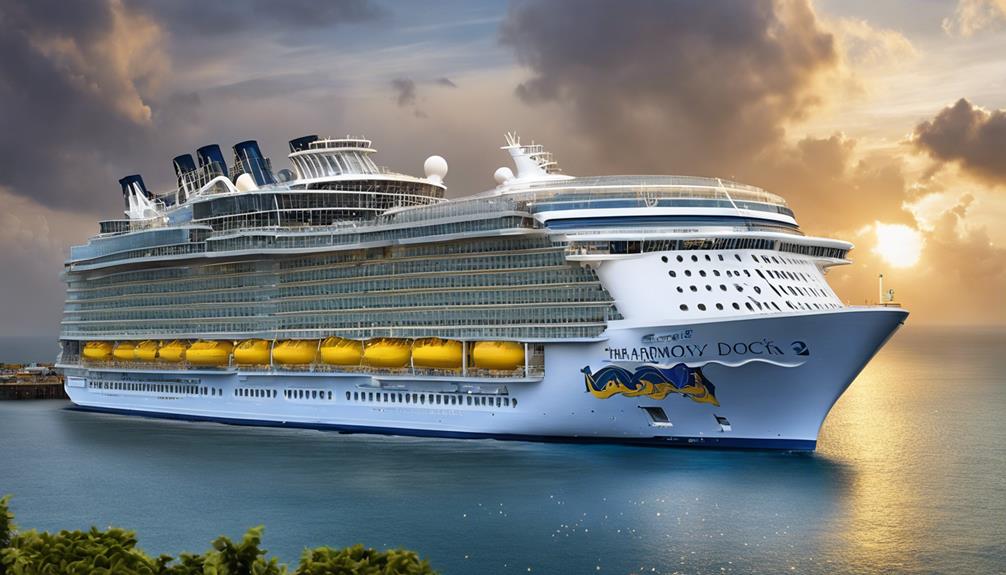
After analyzing docking procedures, communication protocols, and potential technical issues, the collision of Harmony of the Seas with the dock in Jamaica was determined to be caused by pilot misdirection, as stated by the Minister of Tourism. The incident resulted in minor cosmetic damage to the ship's stern, including dents and paint scrapes, but fortunately, no injuries were reported among passengers or crew during the collision in Falmouth, Jamaica on May 26. Despite the collision, Harmony of the Seas managed to continue its scheduled itinerary without disruptions or delays.
| Causes of the Collision | Impact |
|---|---|
| Pilot Misdirection | Minor cosmetic damage to the ship's stern |
| Misaligned Docking Procedures | Dents and paint scrapes observed |
| Lack of Communication | No reported injuries among passengers or crew |
| Technical Issues | Incident occurred during docking maneuver |
| External Factors | Continued scheduled itinerary without delays |
Impact on Cruise Itinerary

Despite the collision with the dock in Jamaica, Harmony of the Seas maintained its cruise itinerary without any disruptions. The impact on the cruise itinerary was minimal, allowing passengers to continue enjoying their vacation as planned.
Here are three key points to consider:
- Uninterrupted Schedule: The collision didn't cause any delays in the ship's itinerary. Passengers could relax and explore the scheduled ports of call without changes to their plans.
- Smooth Transition to Labadee: Harmony of the Seas proceeded to Labadee, Haiti, as scheduled after the incident. This seamless transition ensured that passengers could still experience the delights of this tropical destination without any interruptions.
- Passenger Experience: Despite the collision, passengers were still able to make use of the ship's facilities, such as the zip-line and slide. This allowed them to continue enjoying their cruise experience to the fullest, unaffected by the earlier mishap.
Legal Implications and Responsibilities

When considering the legal implications and responsibilities arising from the collision between Harmony of the Seas and the dock in Jamaica, it's essential to assess the liability for damages and the potential consequences for all parties involved.
Investigations by maritime authorities will be crucial in determining the sequence of events leading to the collision and allocating responsibility among the ship's crew, the pilot, and the port authorities.
Insurance coverage and liability assessments will play a significant role in the legal process following the incident.
Liability for Damages
Legal responsibility for the damages incurred in the Harmony of the Seas collision incident likely rests with the ship operator, Royal Caribbean. As the investigation unfolds, several key aspects regarding liability for damages come into play:
- Repair Costs: Royal Caribbean is responsible for covering the repair expenses for both the Harmony of the Seas and the damaged dock structure.
- Determining Factors: Investigations will delve into potential causes such as pilot error, mechanical failures, or other contributing factors to ascertain liability.
- Financial Responsibility: Insurance coverage and maritime laws will be crucial in determining the extent of financial responsibility Royal Caribbean holds for the damages caused by the collision.
Investigation and Consequences
The ongoing investigation into the collision involving Harmony of the Seas in Jamaica focuses on unraveling the legal implications and responsibilities stemming from the incident.
Authorities are assessing the responsibilities of the pilot, crew, and the cruise line to determine potential consequences such as fines, legal actions, or changes in docking procedures.
Accountability will be assigned based on the investigation findings, which will also identify factors contributing to the collision.
This incident may prompt revisions in regulations or the implementation of enhanced safety measures to prevent similar occurrences in the future.
As the investigation progresses, the focus remains on understanding the sequence of events, clarifying responsibilities, and ensuring that appropriate consequences are upheld to maintain safety and accountability.
Safety Measures and Precautions

In maintaining a secure environment onboard, Royal Caribbean upholds stringent safety protocols and provides comprehensive training to its crew members for effective handling of emergency situations. This commitment to safety is evident through regular safety drills and exercises conducted onboard to ensure preparedness for any potential incidents. The safety of passengers and crew is a top priority for Royal Caribbean, emphasizing the importance of maintaining a secure environment to guarantee passenger well-being.
Deeper Insights:
- Safety Protocols: Royal Caribbean's strict adherence to safety protocols underscores its dedication to incident prevention and ensuring a safe maritime operation environment.
- Crew Training: Thorough training programs equip crew members with the necessary skills to respond promptly and effectively during emergencies, fostering a culture of preparedness.
- Reputation and Passenger Well-being: By prioritizing safety and implementing robust safety measures, Royal Caribbean maintains its reliable reputation and upholds its commitment to passenger well-being.
Future Cruise Safety Measures

We can anticipate that future cruise safety measures will likely focus on enhancing emergency protocols and implementing structural improvements to ships.
These enhancements could involve advanced training for crew members and the installation of technology such as sensors or advanced docking systems.
Furthermore, establishing improved communication procedures between the ship's bridge team and port authorities could also be a key area of development to prevent similar incidents from occurring in the future.
Enhanced Emergency Protocols
Enhanced emergency protocols for future cruise safety measures might include more frequent safety drills and simulations for crew members. To ensure a comprehensive approach to safety, cruise lines could consider implementing the following measures:
- Utilizing advanced docking technologies to enhance precision and avoid collisions.
- Improving communication systems between onboard crew and port authorities for seamless coordination.
- Providing enhanced emergency response training for crew members to effectively handle unforeseen incidents.
These measures aim to bolster the preparedness of cruise staff, enhance operational safety, and mitigate risks associated with docking procedures. By focusing on these aspects, cruise lines can work towards a safer and more secure environment for both passengers and crew members.
Ship Structural Improvements
Considering the imperative need for heightened safety measures in the cruise industry, exploring ship structural enhancements emerges as a crucial avenue to prevent potential collisions with docks. Reinforced hull designs can offer better impact resistance, reducing the risk of damage during docking procedures in the Caribbean and other regions.
Incorporating advanced sensors and maneuvering systems enhances docking precision, aiding ships in navigating challenging port environments. Regular maintenance checks on docking equipment and infrastructure are essential to mitigate collision risks and ensure operational safety.
Collaboration with port authorities to establish updated safety protocols and guidelines further bolsters overall docking safety measures. By prioritizing these structural improvements, cruise lines can proactively work towards a safer and more secure maritime environment for passengers and crew alike.
Frequently Asked Questions
What Was the Damage to the Harmony of the Seas in Jamaica?
We observed minor cosmetic damage on the Harmony of the Seas in Jamaica, with dents and paint scrapes on the stern. Fortunately, the impact was limited to the exterior, sparing critical systems. No injuries occurred, and passenger facilities remained operational.
What Was the Water Incident on Harmony of the Seas?
The water incident on Harmony of the Seas involved a collision during docking in Falmouth, Jamaica. It caused cosmetic damages to the ship's stern, but no injuries occurred. The collision did not affect ship operations or the voyage itinerary.
What Happened on the Harmony of the Seas?
We saw the Harmony of the Seas navigate too close to the dock, resulting in a minor collision. Thankfully, no harm was done to crew or guests. The ship continued its journey smoothly, undeterred by the incident.
What Is the Largest Cruise Ship in the World?
The largest cruise ship in the world is the Symphony of the Seas. It measures around 1,188 feet in length and can accommodate over 6,600 passengers and 2,200 crew members. With various amenities, it offers a luxurious cruising experience.
Conclusion
In light of the collision incident involving Harmony of the Seas in Jamaica, it's evident that swift repairs and efficient recovery efforts were pivotal in maintaining the ship's itinerary.
Despite the minor cosmetic damage and the collapse of a mooring pylon, the cruise continued without delays. This showcases the resilience and resourcefulness of the crew in ensuring the safety and well-being of passengers and crew members.

